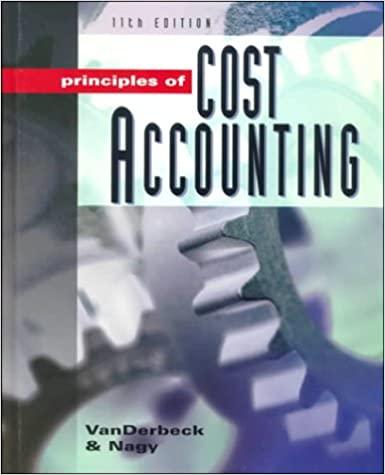Answered step by step
Verified Expert Solution
Question
1 Approved Answer
1. 2. 3. 4. Bridget Company uses activity-based costing. The company has two products: A and B. The annual production and sales of Product A
1.


2.


3.


4.


Bridget Company uses activity-based costing. The company has two products: A and B. The annual production and sales of Product A is 2,000 units and of Product B is 3,000 units. There are three activity cost pools, with estimated total cost and expected activity as follows: Estimated Cost Expected Activity Product A Product B Total Activity Cost Pool Activity 1 Activity 2 Activity 3 $9.000 12,000 48.000 400 100 400 350 400 1.200 750 500 1.600 The cost per unit of Product B under activity-based costing is closest to which of the following? $24.10 $16,60 $35.38 $31.90 Furniture Company uses an activity-based costing system in which there are three activity cost pools. The company has provided the following data concerning its costs and its activity-based costing system: Costs: Manufacturing overhead Selling and administrative expenses Total $600,000 300.000 $900,000 Distribution of Resource Consumption: Order Size Activity Cost Pools Customer Other Support 50% 5% Total 45% 100% Manufacturing overhead Selling and administrative expenses 40% 45% 15% 100% The "Other" activity cost pool consists of the costs of idle capacity and organization-sustaining costs. You have been asked to complete the first stage allocation of the costs to the activity cost pools. How much cost, in total should not be allocated to orders and customer support in the second stage of the allocation process if the activity-based costing system is used for internal decision making? $120,000 $80,000 $0 $75,000 Dierich Company uses an activity-based costing system with three activity cost pools. The company has provided the following data concerning its costs and its activity-based costing system: Costs: Manufacturing overhead Selling and administrative expenses Total $600,000 220,000 $820,000 Distribution of Resource Consumption: Order Size Total Activity Cost Pools Customer Other Support 75% 100 15% 100 Manufacturing overhead Selling and administrative expenses 60% 20% 20% 100% The "Other" activity cost pool consists of the costs of idle capacity and organization-sustaining costs. You have been asked to complete the first stage allocation of costs to the activity cost pools. How much cost, in total, would be allocated in the first-stage allocation to the Order Size activity cost pool? $492,000 $123,000 $307,500 $ $222,000 Dideda Company uses an activity-based costing system with three activity cost pools. The company has provided the following data concerning its costs and its activity-based costing system: Costs: Manufacturing overhead Selling and administrative expenses Total $360,000 240.000 $600,000 Distribution of Resource Consumption: Order Size Activity Cost Pools Customer Other Support 65% 10% Total 25% 100% Manufacturing overhead Selling and administrative expenses 60% 20% 20% 100 The "Other" activity cost pool consists of the costs of idle capacity and organization-sustaining costs. You have been asked to complete the first-stage allocation of costs to the activity cost pools. How much cost, in total, would be allocated in the first-stage allocation to the Order Size activity cost pool? O $150,000 $234,000 $255,000 $360,000
Step by Step Solution
There are 3 Steps involved in it
Step: 1

Get Instant Access to Expert-Tailored Solutions
See step-by-step solutions with expert insights and AI powered tools for academic success
Step: 2

Step: 3

Ace Your Homework with AI
Get the answers you need in no time with our AI-driven, step-by-step assistance
Get Started


